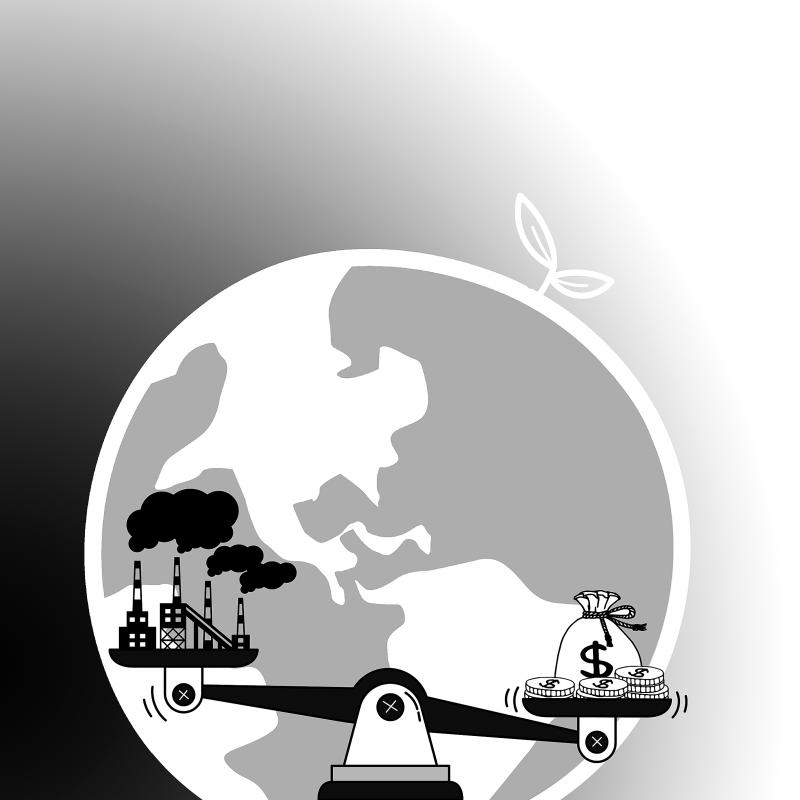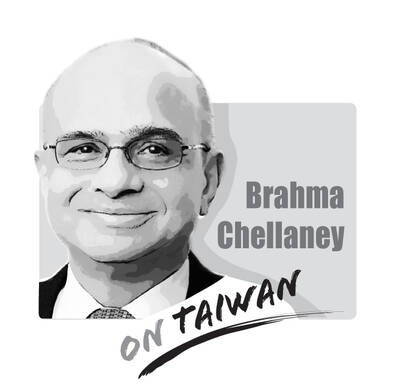Investment in providing electricity and clean cooking to hundreds of millions of people is “orders of magnitude” below what is needed to meet a global goal for everyone on the planet to use modern, green energy by 2030, researchers said on Thursday.
An estimated US$41 billion is required each year to supply electric power to all homes worldwide, but in 2018, only roughly a third of that, US$16 billion, was committed for this purpose in 20 key developing countries, an annual tracking report said.
Fossil fuels accounted for the largest share of electricity finance allocations — for the first time in at least six years.

Illustration: June Hsu
The trend was driven mainly by grid-connected coal and gas projects in Bangladesh, the researchers said, calling for an end to backing for carbon-heavy power plants.
Finance for clean cooking to replace harmful energy sources such as kerosene and charcoal in 2018 tripled to US$131 million — but is still just a fraction of the estimated annual US$4.5 billion needed for universal access by 2030, they said.
Donor governments and development banks provided less than half of financing for electrification, with the rest coming from private investors. For cooking, public money accounted for 60 percent.
“As we deal with the ongoing challenges of COVID-19, and the ever-growing impacts of climate change, the need for modern, sustainable energy access has never been more important,” Sustainable Energy for All (SEforALL) chief executive officer Damilola Ogunbiyi said.
“Yet [the report] shows a chronic lack of investment in electricity and clean cooking for those that need it most,” said Ogunbiyi, who also cochairs UN-Energy.
In Chad, 88 percent of people have no access to electricity, but researchers did not find even US$1 of financing for power in the poor Central African country in 2018, said Olivia Coldrey, technical lead for energy finance of SEforALL, an international body that coproduced the research.
Today, an estimated 789 million people still live without affordable, reliable electricity sources, mainly in Africa and Asia, while about 2.8 billion use dirty cooking methods.
The report showed that financing for grid-connected renewable energy declined for the first time since 2013, while the share of investment in mini-grids and off-grid solutions — often solar — was less than 1.5 percent of the total for electricity in 2018.
SEforALL said that low investment in locally produced electricity was especially worrisome in the context of the COVID-19 pandemic, as it is vital both for powering rural healthcare and to deliver planned vaccines, which must be kept at very cold temperatures.
In a statement, SEforALL said that the latest data suggested that “the world will be delayed by decades” in meeting its 2030 goal for universal access to sustainable energy sources.
Researchers said that the increased funding for fossil fuel projects — about 40 percent of it provided by China — contradicted global efforts to tackle climate change.
A move back to dirty energy in the push to boost economies slammed by the pandemic is a risk, the report said.
The researchers cited India, which — despite rapid progress toward universal electrification driven by an ambitious green energy policy — has started auctioning more than 40 state-owned coal mines in response to COVID-19.
“We must prevent these types of policy reversals if we are to realize a long-term, green, resilient and inclusive economic recovery after COVID-19,” the report added.
Barbara Buchner, global managing director of the Climate Policy Initiative, a think tank that partnered on the research, said that governments should put their stimulus spending into clean energy and end support for fossil fuels, including subsidies.
“What we really need ... is to build our economies forward in a more sustainable way,” she said.
Buchner called for policies to support small and medium-sized local companies selling home solar systems or clean-cooking stoves, as well as financial innovation to reduce the risks for larger private investors coming into these markets.
Renat Heuberger, chief executive of sustainability company South Pole — which produced a complementary report showing delays in paying out nearly 60 percent of funds committed for energy access from 2002 to 2018 — said that financing models were not well suited to realities on the ground.
Renewable energy deals in countries like Nigeria or India have been held up or failed because of weak institutions, unfavorable feed-in tariffs and insufficient knowledge among local banks more used to backing fossil fuel projects, Heuberger said.
Energy access specialists have also expressed concern about the negative impact of economic lockdowns and resulting recessions on off-grid power companies in Africa and Asia.
Data from trade association GOGLA show that sales of off-grid solar products fell sharply in the first half of this year, as the pandemic hit trade and incomes in developing nations.
However, the sector, which grew at an annual rate of 10 percent in the previous three years, last week got a boost when the Green Climate Fund approved a US$30 million investment to support off-grid energy firms during the pandemic.
Starting next year, the Energy Access Relief Facility aims to offer US$100 million in loans to help about 90 companies ride out the COVID-19 crisis.
Leslie Labruto, global head of energy at Acumen, a nonprofit organization that helped develop the fund, said that the impact of the pandemic, while severe, had seen customers continue to prioritize payments for solar energy services even though new sales stalled.
Relief loans could shore up companies to start growing again in 2021, once COVID-19 restrictions ease and sales pick up, Labruto said.
“I am hoping we can make up ground in 2021 and beyond [for] energy access to reach its full potential, which is to see rural thriving economies and power in every home,” she said.
Recently, China launched another diplomatic offensive against Taiwan, improperly linking its “one China principle” with UN General Assembly Resolution 2758 to constrain Taiwan’s diplomatic space. After Taiwan’s presidential election on Jan. 13, China persuaded Nauru to sever diplomatic ties with Taiwan. Nauru cited Resolution 2758 in its declaration of the diplomatic break. Subsequently, during the WHO Executive Board meeting that month, Beijing rallied countries including Venezuela, Zimbabwe, Belarus, Egypt, Nicaragua, Sri Lanka, Laos, Russia, Syria and Pakistan to reiterate the “one China principle” in their statements, and assert that “Resolution 2758 has settled the status of Taiwan” to hinder Taiwan’s
Singaporean Prime Minister Lee Hsien Loong’s (李顯龍) decision to step down after 19 years and hand power to his deputy, Lawrence Wong (黃循財), on May 15 was expected — though, perhaps, not so soon. Most political analysts had been eyeing an end-of-year handover, to ensure more time for Wong to study and shadow the role, ahead of general elections that must be called by November next year. Wong — who is currently both deputy prime minister and minister of finance — would need a combination of fresh ideas, wisdom and experience as he writes the nation’s next chapter. The world that
The past few months have seen tremendous strides in India’s journey to develop a vibrant semiconductor and electronics ecosystem. The nation’s established prowess in information technology (IT) has earned it much-needed revenue and prestige across the globe. Now, through the convergence of engineering talent, supportive government policies, an expanding market and technologically adaptive entrepreneurship, India is striving to become part of global electronics and semiconductor supply chains. Indian Prime Minister Narendra Modi’s Vision of “Make in India” and “Design in India” has been the guiding force behind the government’s incentive schemes that span skilling, design, fabrication, assembly, testing and packaging, and

Can US dialogue and cooperation with the communist dictatorship in Beijing help avert a Taiwan Strait crisis? Or is US President Joe Biden playing into Chinese President Xi Jinping’s (習近平) hands? With America preoccupied with the wars in Europe and the Middle East, Biden is seeking better relations with Xi’s regime. The goal is to responsibly manage US-China competition and prevent unintended conflict, thereby hoping to create greater space for the two countries to work together in areas where their interests align. The existing wars have already stretched US military resources thin, and the last thing Biden wants is yet another war.